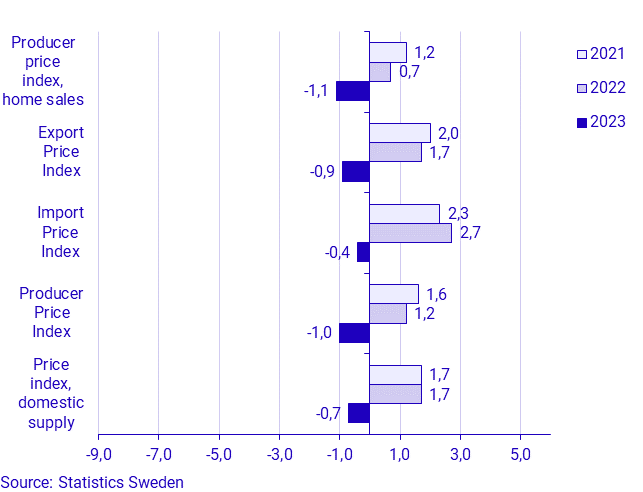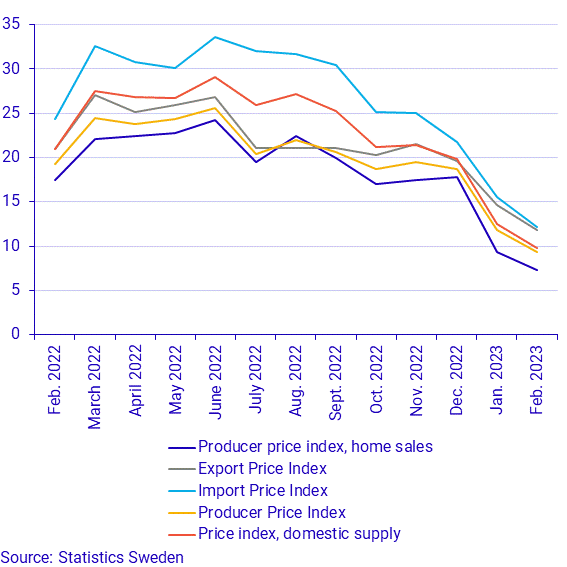Producer and Import Price Index, February 2023
Lower prices on energy related goods contributed to the decline on all markets in February 2023
Statistical news from Statistics Sweden 2023-03-24 8.00
The Producer Price Index decreased by 1.0 percent in February compared to January 2023. Prices decreased by 0.9 percent on the export market and by 1.1 percent on the domestic market. On the import market, prices decreased by 0.4 percent. The annual rate according to the Producer Price Index was 9.3 percent in February (11.8 percent in January).
In brief
- Energy related goods contributed to the downturn on the domestic market by 1.4 percentage points.
- The monthly rate for refined petroleum products was negative on all markets.They decreased by 5.2 percent within the Price Index for Domestic Supply, and by 4.8 percent within the Producer Price Index
- The annual rate for consumer goods in Price Index for Domestic Supply was 16.0 percent in February (compared to 16.2 percent in January).
| Total: SPIN B–E* | Change, percent (monthly) |
Change, percent (yearly) |
|---|---|---|
| January 2023– February 2023 |
February 2022– Februari 2023 |
|
| Producer Price Index, home sales | ‑1.1 | 7.3 |
| Export Price Index | ‑0.9 | 11.8 |
| Import Price Index | ‑0.4 | 12.2 |
| Producer Price Index | ‑1.0 | 9.3 |
| Price Index for domestic supply | ‑0.7 | 9.8 |
*Products from mining and quarrying, manufactured products, electricity, gas, heating, cooling, water and waste collection.
Changes in the last month
The monthly rate of change was negative on all markets in February. This resulted in negative monthly rate of change for both Producer Price Index and Price Index for Domestic Supply during the same period.
The largest negative contribution on the domestic market came from lower prices on trade services of electricity. Prices also fell within refined petroleum products, basic chemicals and machining services. This downturn was offset by higher prices on motor vehicles, trailers and semi-trailers and other machinery and equipment.
On the export market the main negative contribution came from lower prices on refined petroleum products. Prices also decreased within generation of electricity, pulp, basic chemicals, basic iron and steel as well as for electrical equipment. This downturn was offset by higher prices on motor vehicles, trailers and semi-trailers and food products.
The main contribution to the decrease on the import market came from lower prices on crude oil and refined petroleum products. Prices also fell within natural gas, computers and peripheral equipment, basic chemicals, electrical equipment and generation of electricity. This downturn was offset by higher prices on motor vehicles, trailers and semi-trailers, food products, basic pharmaceutical products and pharmaceutical preparations, basic iron and steel, as well as for structural metal products.
| Product group according to SPIN 2015 | Largest contributions, in percentage points, to total percentage change, January 2023– February 2023 |
||||
|---|---|---|---|---|---|
| Producer Price Index, home sales |
Export Price Index |
Import Price Index |
|||
| 06.1 | Crude oil | ‑0.4 | |||
| 06.2 | Natural gas | ‑0.1 | |||
| 10 | Food products | 0.1 | 0.2 | ||
| 17.11 | Pulp | ‑0.2 | |||
| 19.2 | Refined petroleum products | ‑0.3 | ‑0.4 | ‑0.2 | |
| 20.1 | Basic chemicals, fertilisers and nitrogen compounds, plastics and synthetic rubber in primary forms | ‑0.1 | ‑0.1 | ‑0.1 | |
| 21 | Basic pharmaceutical products and pharmaceutical preparations | 0.1 | |||
| 24.1 | Basic iron and steel | ‑0.1 | 0.1 | ||
| 25.1 | Structural metal products | 0.1 | |||
| 25.62 | Machining services | ‑0.1 | |||
| 26.2 | Computers and peripheral equipment | ‑0.1 | |||
| 27 | Electrical equipment | ‑0.1 | ‑0.1 | ||
| 28 | Other machinery and equipment | 0.1 | |||
| 29 | Motor vehicles, trailers and semi-trailers | 0.2 | 0.1 | 0.2 | |
| 35.11A | Generation of electricity | ‑0.2 | ‑0.1 | ||
| 35.14 | Trade services of electricity | ‑1.0 | |||

Changes in the last year
The annual rate for the domestic market was 7.3 percent in February (9.3 percent in January). The annual rate for the export market was 11.8 percent during the same period (14.6 percent in January). On the import market, the annual rate in February was 12.2 percent (15.6 percent in January).
The annual rate of the Producer Price Index was 9.3 percent in February. Compared with February 2022, prices rose by 5.9 percent on energy-related products. Prices increased by 15.4 percent on consumer goods and increased by 11.4 percent on capital goods. The annual rate of the Producer Price Index excluding energy-related products was 11.2 percent.
The annual rate of the Price Index for Domestic Supply was 9.8 percent in February. Compared with February 2022, prices rose by 2.1 percent on energy-related products. Prices increased by 16.0 percent on consumer goods and increased by 11.3 percent on capital goods. The annual rate of the Price Index for Domestic Supply excluding energy-related products was 12.0 percent.

Changes in exchange rates
An appreciation or depreciation of the Swedish currency lowers or raises export and import prices in Swedish kronor. Prices at the producer and import stages are converted from foreign currencies to Swedish kronor according to Swedish Customs’ exchange rates.
| Currency | Change, percent (monthly) |
Change, percent (yearly) |
|---|---|---|
| January 2023– February 2023 |
February 2022– February 2023 |
|
| DKK | ‑0.9 | ‑7.4 |
| EUR | ‑0.9 | ‑7.4 |
| GBP | ‑0.3 | ‑2.2 |
| NOK | 0.7 | ‑0.9 |
| USD | 1.3 | ‑11.2 |
A positive number means that the Swedish krona was strengthened against that currency.
Definitions and explanations
The Producer Price Index home sales (HMPI) measures changes in Swedish producers’ prices of goods manufactured and sold in Sweden.
The Export Price Index (EXPI) measures changes in Swedish producers’ prices of goods manufactured in Sweden and sold outside Sweden, both within and outside the EU.
The Import Price Index (IMPI) measures changes in the prices of imports of goods into Sweden.
The Producer Price Index (PPI) measures changes in the prices of Swedish producers’ total sales, obtained by combining the HMPI and the EXPI.
The Price Index for Domestic Supply (ITPI) measures changes in the prices of goods sold in Sweden, obtained by combining the HMPI and the IMPI.
Next publishing will be
Statistics for March will be published on 2023-04-25 at 08:00.
Statistical Database
More information is available in the Statistical Database
Feel free to use the facts from this statistical news but remember to state Source: Statistics Sweden.
